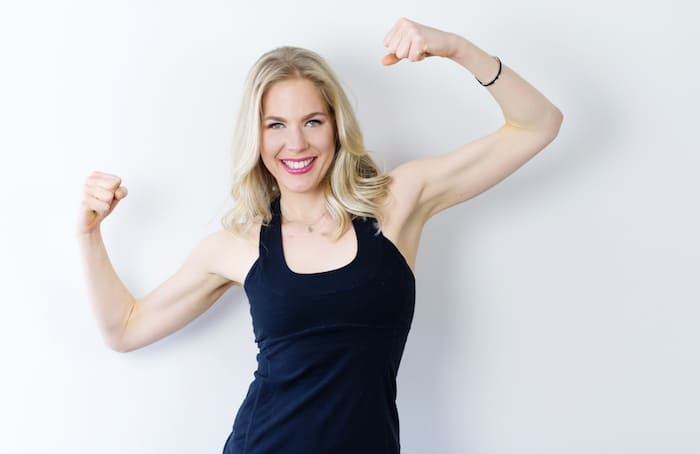
By Kathleen Trotter
Too many of us inadvertently self-sabotage with what I call “unhealthy healthy choices.” We think our choices are healthy, when in reality our “healthy” choices are not serving our goals. The “I am working so hard and nothing is happening” feeling is unbelievably frustrating and demoralizing — it’s one thing to fall short of a goal when intentionally eating cake and skipping workouts; it’s another thing to fall short when trying to stay on the straight and narrow.
I divide unhealthy healthy foods into three categories: “the wolf,” the “5 is not 1,” and the “salad meal.”
The Process
First, journal what you eat for a few days so you can analyze what you actually consume — versus what you think you consume. We tend to overestimate our healthy choices and underestimate our unhealthy ones.You don’t need me to tell you to watch your chips and fried foods, but you might be surprised at how regularly you indulge in what you think of as “treats.” Treats eaten daily are no longer treats; they are your daily diet.
Next, pinpoint your “unhealthy healthy foods.”
The “Wolf”
Think foods high in sugar and/or salt that masquerade as “health food.” Store-bought muffins (just cake in the shape of a muffin), juice (liquid sugar), most store-bought granola (sugar and fat), frozen “healthy” dinners (preservatives and salt), most gluten-free desserts (just because they don’t have gluten doesn’t mean they are healthy), and “fat-free” snacks (usually devoid of nutrients and full of artificial crap and sugar).

The “5 is NOT 1”
Think foods that are healthy in moderation (as in, if you eat one or two portions), but not when consumed willy-nilly. Almonds, peanut butter, crackers, high-GI fruits (e.g., mangos, pineapple), and hummus.
This category is especially significant for people who want to lose weight. The key to weight loss is not only food selection, but portion control. Too often, when one knows something is healthy, one is less mindful and doesn’t worry about portion control. It is true that nuts like almonds are healthy, but too many of us grab handful after handful in a day. An entire large bag is not part of a nutritionally balanced day. Copious almonds (although, yes, more nutrient dense than copious potato chips), are still not helpful to your health quest, especially if one of your goals is to lose weight.
The Salad Meal
Do NOT be fooled — just because something is called a salad does NOT make it the best choice.
We see “salad” and think “healthy” and “good for weight loss.” Wrong. Dressings are usually laden with sugar and filled with preservatives and unhealthy fat, and too often salads have additives like noodles, fried ingredients, taco chips, or dried fruits. Often in restaurants salads are just a bunch of unhealthy ingredients assembled together.
-Be wary of dressings. They have hidden sugar and unhealthy fat. Either ask for dressing on the side or ask for olive oil, mustard, and balsamic so you can make your own
-Watch for salads full of grains. It’s not that grains are bad. Just know when you are ordering a grain bowl, not a mainly vegetable-filled salad. Own your choices.
-Read the ingredients carefully and ask your server questions. Watch for filler non-vegetable ingredients; set your antenna for sugar (candied nuts, dried fruit), fried foods (crispy nuts, tortilla chips), large portions of cheeses, unhealthy fats (sour cream), processed foods, vegetables drenched in oils (grilled vegetables), empty complex carbs (noodles), and salt (salted nuts, meats).
-Watch portion sizes. Salads can often be big enough to feed three people. Portion sizes count.
Main take-away
It is one thing not to reach your fitness and health goals if you are consciously making unhealthy choices, but it is really frustrating to feel like you are making all the right choices and giving it “your all” and still not reach your goals. Challenge yourself. Journal your food. Become aware of sneaky foods that seem healthy but that end up stealthily sabotaging progress. Actually cutting out sweets and fried food is hard work, but knowing they need to be eliminated (or at least reduced) is usually a no-brainer. The less obvious culprits — “unhealthy health foods” — tend to slide under the radar and inadvertently sabotage progress.
Become mindful of what, how, and why you eat! Don’t try to “scam the system” — a gluten-free cookie can be made of as much crap as a regular cookie. Plus, no matter what you are eating, portion control is key! Don’t stand at a party or at your kitchen counter and snack mindlessly. Sit down and enjoy what you are eating. If you decide to have an amazing piece of cake, great. Enjoy your treat. Just have one small slice, not 7.
Kathleen Trotter (MSc) is a fitness expert, nutrition and life coach, media personality and author of two books including her most recent Your Fittest Future Self. Connect with her on social media at FitByKathleenT or through her website KathleenTrotter.com






